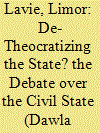| Srl | Item |
| 1 |
ID:
181108


|
|
|
|
|
| Summary/Abstract |
The ‘Jasmine Revolution’ that toppled Tunisian president Zine al-‘Abidine Ben ‘Ali on 14 January 2011, and the 25 January 2011 uprising that toppled Egyptian President Husni Mubarak had similar characteristics yet different outcomes. While the Tunisian experience led to democratization and to a non-violent transfer of power, the Egyptian one led to a reversion to authoritarianism through a military coup and to bloodshed. This paper suggests that the key to understanding the diverse outcomes of the Arab Spring in these countries is the prevalence of consensus/dissensus in each society over the most suitable state model for the post-revolutionary era. The existence of an agreed-upon vision for the post-Arab Spring state in Tunisia—a vision of a ‘civil state’—and a wide controversy over such a model in Egypt was a pivotal factor influencing the level of socio-political cohesion during the transitional period, hence determining whether it is destined for success or failure. A prior agreement between Islamist and Secularist opposition groups over the civil state model spared Tunisia the turmoil that Egypt went through due to the polarization over the desired state model in the post-Mubarak era, which served as a catalyst for the 2013 soft coup against the Muslim Brothers elected president.
|
|
|
|
|
|
|
|
|
|
|
|
|
|
|
|
| 2 |
ID:
191866


|
|
|
|
|
| Summary/Abstract |
Since the Arab uprisings, the ambiguous notion of a civil state (dawla madaniyya) has been gaining a foothold in many Arab states as the ideal state model, at the official and popular levels. Even Saudi Arabia has heard voices advocating a civil state. Whereas such voices were evident in critical newspaper columns, which raised countercriticism by the Saudi religious orthodoxy during the 2000s and 2010s, recently Crown Prince Muḥammad bin Salmān Āl Saʿūd has been increasingly portrayed in the Saudi media as directing the Kingdom toward a modern Islamic civil state, indicating a possible change in the perception of this concept. This article offers a contextual analysis of the Saudi intellectual polemic on the civil state model, which has been taking place for the past fifteen years, its development, meanings, and prospects. The article will also consider the implications of the long-standing debate over the civil state idea taking place in Egypt on the short-lived Saudi contestation, in an effort to enhance the overall understanding of the conception of the civil state in the Arab world.
|
|
|
|
|
|
|
|
|
|
|
|
|
|
|
|
| 3 |
ID:
154875


|
|
|
|
|
| Summary/Abstract |
This article examines the change in the discourse of the Muslim Brothers in Egypt regarding the model of a civil state. It outlines a transition in the doctrine of the movement from an all-Islamic state to a modern nation state with Western norms and institutions. The paper traces milestones in the process that led to the acceptance of the civil model into the Muslim Brothers’ rhetoric and political platform albeit a creative interpretation of the concept. Due to the movement's inconsistency and vagueness using this vision, the article focuses on the post-Mubarak era and the Morsi administration in order to test this shift in practice.
|
|
|
|
|
|
|
|
|
|
|
|
|
|
|
|
| 4 |
ID:
150958


|
|
|
|
|
| Summary/Abstract |
The model of the "civil state" (dawla madaniyya) occupies a central place in the public debate over the character of Egypt following the January 25 Revolution of 2011. The demand to establish a civil state was ostensibly shared by all the political currents in Egypt. However, when these currents attempted to set out agreedupon guidelines for Egypt's future, it soon became clear that they were far from a consensus, and that defining the civil state was at the heart of the controversy. This article examines the roots of this concept in Western political philosophy, tracing its evolution in Egypt from its first appearance in the beginning of the 20th century until the recent debate on its inclusion in Article 1 of the 2014 constitution.
|
|
|
|
|
|
|
|
|
|
|
|
|
|
|
|
| 5 |
ID:
184345


|
|
|
|
|
| Summary/Abstract |
This article offers a new perspective on the extensive discussion of the role of new media in facilitating the 2011 Egyptian uprising by placing it within the historical context of how the state responded to new media in the previous decades. This article uses an archaeological analysis of state media to reveal how the state coped with the news media (newspapers, radio, television, satellite television) in the past to infer the present relationship between the state and the new media (the internet and social media). We discerned a recurring cyclical pattern characterized by a dynamic of openness–adaptation–narrowing, which sheds light on the media’s ability to challenge state authority and on the state’s ability to contain and limit new media. We suggest that the role of the internet and social media in the Egyptian “Arab Spring” should be viewed as being on this continuum, as an extension of processes of state–media relations that had developed in the preceding decades.
|
|
|
|
|
|
|
|
|
|
|
|
|
|
|
|